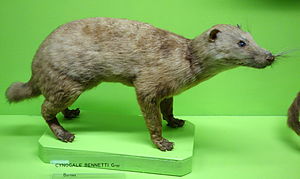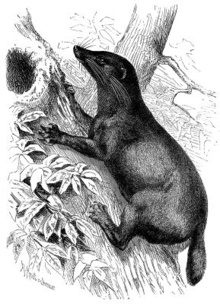Otter civet
| Otter civet | ||||||||||||
|---|---|---|---|---|---|---|---|---|---|---|---|---|

Otter civet ( Cynogale bennettii ), stuffed specimen |
||||||||||||
| Systematics | ||||||||||||
|
||||||||||||
| Scientific name of the genus | ||||||||||||
| Cynogale | ||||||||||||
| JE Gray , 1837 | ||||||||||||
| Scientific name of the species | ||||||||||||
| Cynogale bennettii | ||||||||||||
| JE Gray, 1837 |
The otter civet ( Cynogale bennettii ) is a species of predator from the family of the stealthy cats (Viverridae) adapted to aquatic life . She lives in Southeast Asia and is also known by her Malay name, Mampalon .
features
Atypical for a crawl cat, the otter civette has a thick, massive body and a very short tail. Their head body length is around 57 to 68 centimeters, plus a tail that is around 13 to 20 centimeters long. The weight of these animals is around 3 to 5 kilograms. The snout is much flatter and wider than that of other crawling cats. The fur is gray-brown. In adaptation to the aquatic life, the nostrils are on the top of the snout and, like the ear openings, can be closed. The strongly elongated, white whisker hairs on the face are characteristic. Webbed feet are only present on the hind legs and are not very well developed there either.
Distribution and habitat
Mampalons inhabit the Malay Peninsula and the islands of Sumatra , Java and Borneo . A second population may also exist in northern Vietnam and southern China . In addition to unconfirmed sightings, there is only one find of this population, which was made in North Vietnam in 1926. According to some researchers, this population is a separate species, Cynogale lowei .
Habitat of the otter civets are river banks and swamp regions within tropical rainforests .
Way of life
The otter civet is an agile swimmer, but just as often moves on land and can also climb trees. Due to their nocturnal, withdrawn lifestyle, little is known about their behavior.
They feed on fish, mussels and crabs, but also on mice and birds. Allegedly, the otter civet should lie in the water like a crocodile , only looking out the nostrils to attack prey that comes to the water to drink; many zoologists question these representations. As with most crawling cats, fruits also make up part of their diet.
Little is known about reproduction. Probably the litter size is two or three young animals.
threat
Otter civets are endangered species; the main danger lies in the loss of habitat through forest clearing. As the data are insufficient, the size of the total population cannot be given. The IUCN estimates, however, that the population has decreased by half in the last 15 years (three generations) and lists them as endangered.
literature
- Ronald M. Nowak: Walker's Mammals of the World. 2 volumes. 6th edition. Johns Hopkins University Press, Baltimore MD et al. 1999, ISBN 0-8018-5789-9 .
Web links
- Cynogale bennettii in the Red List of Threatened Species of the IUCN 2008. Posted by: JW Duckworth u. a., 2008. Retrieved January 6, 2009.

